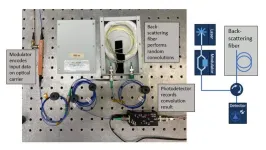(Press-News.org) WASHINGTON – U.S. Naval Research Laboratory (NRL) researchers deliver novel contribution in fiber optics computing, Fiber Optic Computing Using Distributed Feedback paper recently published in Communications Physics journal, brings the Navy one step closer to faster, more efficient computing technologies.
Optical computing uses the properties of light, such as its speed and ability to carry large amounts of data, to process information more efficiently than traditional electronic computers.
In collaboration with Sandia National Laboratories and the University of Central Florida, NRL is aiming to increase processing speeds, reduce energy consumption, and enable new applications in fields such as data processing, telecommunications, and artificial intelligence.
“This paper marks a significant advancement in optical computing,” said Brandon Redding, Ph.D., a research physicist from the NRL Optical Sciences Division. “It is the first to employ distributed feedback in optical fiber, combining temporal encoding with low-loss, partially reflective fiber. Our approach offers scalability to process multiple neurons simultaneously, along with high-speed performance and a compact, lightweight, and power-efficient design, as the entire system is fiber-coupled and does not require free-space optics.”
The Navy is rapidly adopting machine learning algorithms for a wide range of applications. Many of these applications are time and energy-sensitive. For instance, image or target recognition tasks where objects require identification in real time.
“Many of these applications involve forward deployed, often autonomous platforms with limited power availability,” Redding said. “We intend to use analog photonics, which has fundamentally different energy scaling than Von Neumann based digital electronics — to perform these machine learning tasks with lower power consumption and with lower latency. In the current paper, we performed an energy consumption analysis showing the potential for 100-1000x lower power consumption than a GPU depending on the problem size.”
This research shows how optics can be used to conduct valuable computing tasks using passive random projections, in this case non-linear random convolutions. This is counter to how most machine learning works, which typically requires extensive training to set the weights of a neural network.
“Instead, we show that random weights can still perform useful computing tasks,” Redding said. “This is significant because we can apply random weights very efficiently in the optical domain simply by scattering light off of a rough surface, or, as we show in this paper, scattering light off non-uniformities in an optical fiber.”
In traditional, digital electronics-based computers, there wouldn’t be much advantage to doing this because every multiplication operation is just as expensive, in terms of time and energy, whether multiplying by a random number or by a value carefully selected through training.
“This implies that in the optical domain, we may want to design our neural network architectures differently to take advantage of the unique features of optics — some things are easier to do in optics and some things are harder, therefore simply porting the same neural network architecture that was optimized for digital electronics implementations may not be the ideal solution in the optical domain,” Redding said.
A more subtle feature of NRL’s fiber platform is performing convolutions, similar to a convolutional neural network (CNN), a rarity for an optical computing platform. Convolutions are very powerful for tasks like image processing, which led to the widespread use of CNNs within the Department of Defense image processing applications.
“The Navy payoff is implementing machine learning algorithms faster, reducing the delay before we arrive at an answer,” said Joseph Murray, Ph.D., a research physicist from the NRL Optical Sciences Division. “We are also exploring applying these algorithms directly on analog data without requiring intermediate digitization and storage, which could have a significant benefit when processing high bandwidth data that is difficult to record and analyze in real-time, such as: high-resolution image data or RF data for electronic warfare applications.”
This research is sponsored by the NRL Base Program designed to develop fundamental science. The research, both theoretical and experimental, is concerned with discovering and understanding the basic physical principles and mechanisms involved in optical devices, and materials.
“The current paper is the proof-of-principle that we can do useful computing with these fixed, random optical projections, as tested on benchmark tasks like image recognition of handwritten digits,” said Joseph Hart, Ph.D., a research physicist from the NRL Optical Sciences Division. “We also tested this on a SONAR dataset task to show how this platform can discriminate between SONAR signatures from rocks versus underwater mines as a more Navy-specific application.”
The Optical Sciences Division carries out a variety of research, development, and application-oriented activities in the generation, propagation, detection, and use of radiation in the wavelength region between near-ultraviolet and far-infrared wavelengths. The Division serves the Laboratory and the Navy as a consulting body of experts in optical sciences.
About the U.S. Naval Research Laboratory
NRL is a scientific and engineering command dedicated to research that drives innovative advances for the U.S. Navy and Marine Corps from the seafloor to space and in the information domain. NRL is located in Washington, D.C. with major field sites in Stennis Space Center, Mississippi; Key West, Florida; Monterey, California, and employs approximately 3,000 civilian scientists, engineers and support personnel.
For more information, contact NRL Corporate Communications at (202) 480-3746 or nrlpao@us.navy.mil.
END
NRL research physicists explore fiber optic computing using distributed feedback
2024-03-11
ELSE PRESS RELEASES FROM THIS DATE:
Canals used to drain peatlands are underappreciated hotspots for carbon emissions
2024-03-11
A new study led by UC San Diego Scripps Institution of Oceanography postdoctoral scholar Jennifer Bowen finds that canals used to drain soggy peatlands in Southeast Asia are likely hotspots for greenhouse gas emissions.
The results, published March 8 in Nature Geoscience and supported by the Scripps Institutional Postdoctoral Program and Stanford University’s Precourt Institute for Energy, identify a previously unaccounted for source of emissions from these threatened, carbon-rich landscapes. Findings from the study suggest that the degradation of tropical peatlands in Southeast Asia has released even more planet-warming ...
Nutritional value of meat should be considered when comparing carbon footprints
2024-03-11
The nutritional value of meat must be considered when comparing carbon footprints – that is the key message from a recent study undertaken by Hybu Cig Cymru – Meat Promotion Wales (HCC), Bangor University, Queen’s University, and the Agri-Food and Biosciences Institute (AFBI).
The scientific paper, published in the journal Frontiers in Sustainable Food Systems using data from the Welsh Lamb Meat Quality project, focuses on different lamb production systems, specifically the ‘finishing’ period – at the end of which lambs have reached the required weight, meat and fat cover for ...
Microscopy plus deep learning to advance prostate cancer diagnosis
2024-03-11
Prostate cancer stands as a prevalent threat to men's health, ranking second in cancer-related deaths in the United States. Each year, approximately 250,000 men in the U.S. receive a prostate cancer diagnosis. While most cases have low morbidity and mortality rates, a subset of cases demands aggressive treatment. Urologists assess the need for such treatment primarily through the Gleason score, which evaluates prostate gland appearance on histology slides. However, there's considerable variability in interpretation, leading to both undertreatment and overtreatment.
The current method, based on histology ...
Cancer researchers awarded $3.2 million grant to find better ways to treat advanced melanoma
2024-03-11
A team of investigators from the UCLA Health Jonsson Comprehensive Cancer and the University of Arkansas for Medical Sciences (UAMS) Winthrop P. Rockefeller Cancer Institute was awarded a $3.2 million grant from the National Institutes of Health to identify new ways to prevent and overcome treatment resistance to targeted therapy in patients with all sub-types of cutaneous melanoma, an aggressive form of skin cancer.
Virtually all cutaneous melanomas display genetic alterations that ...
The liver immune system eats up ‘bad cholesterol’
2024-03-11
A new study from Karolinska Institutet in Sweden reveals that immune cells in the liver react to high cholesterol levels and eat up excess cholesterol that can otherwise cause damage to arteries. The findings, published in Nature Cardiovascular Research, suggest that the response to the onset of atherosclerosis begins in the liver.
Cholesterol is a type of fat that is essential for many functions in the body, such as making hormones and cell membranes. However, too much cholesterol in the blood can be harmful, as it can stick to the walls of the arteries ...
New study finds female entrepreneurs do better with guidance from female mentors
2024-03-11
INFORMS Journal Marketing Science Study Key Takeaways:
Female entrepreneurs increase their chances of success and improved performance with female mentors.
One of the key benefits to female entrepreneurs is a mentoring style characterized as “positive engagement.”
BALTIMORE, MD, March 11, 2024 – In business and in life, the power of mentorship has long been understood, but how important is it that your mentor look like you? This question was at the center of a new study, which specifically found that mentor gender has a powerful impact on ...
Using wrist-worn activity trackers to help patients reduce long COVID symptoms
2024-03-11
LA JOLLA, CA—Scientists at the Scripps Research Digital Trials Center have partnered with the health technology company CareEvolution to launch a remote study that will investigate whether wrist-worn devices, such as activity trackers and smartwatches, can help people with long COVID manage and reduce the severity of their symptoms.
“New treatments and interventions are urgently needed,” says the study principal investigator Julia Moore Vogel, PhD. “We’re excited to launch the Long COVID Wearable Study and ...
AI-generated food images look tastier than real ones
2024-03-11
With the Global Nutrition and Hydration Week 2024 starting today, researchers have announced an intriguing discovery – consumers generally prefer AI-generated images of food over real food images, especially when they are unaware of their true nature. The new findings have been published in Food Quality and Preference.
According to the researchers, the results suggest that AI-generated food visuals excel at enhancing the appeal of depicted foods by leveraging key features such as symmetry, shape, glossiness, and overall lighting and colour. All of these are known to contribute significantly ...
Implantable brain-computer interface collaborative community (iBCI-CC) to drive innovation in neurotechnology
2024-03-11
BOSTON – (March 11, 2024) Mass General Brigham is establishing the Implantable Brain-Computer Interface Collaborative Community (iBCI-CC). This is the first Collaborative Community in the clinical neurosciences that has participation from the U.S. Food and Drug Administration (FDA).
BCIs are devices that interface with the nervous system and use software to interpret neural activity. Commonly, they are designed for improved access to communication or other technologies for people with physical disability. Implantable BCIs are investigational devices ...
Political rage on social media is making us cynical
2024-03-11
Political anger and cynicism are rising in the United States and in many democracies worldwide, and both are associated with exposure to political attacks on social media, a new University of Michigan study shows.
Americans use social media to find information and news about politics, but much of the content they see in their feeds is hostile, uncivil and attacking, said lead author Ariel Hasell, assistant professor of communication and media and an affiliate of the Center for Political Studies at the U-M Institute for Social Research.
Hasell ...



